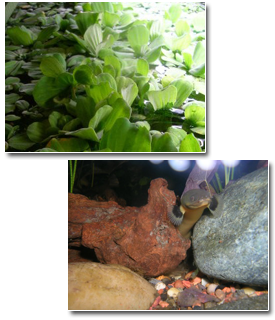Filters
There are three basic forms of filtration and many different ways to achieve them. The basic forms of filtration are:
1) Mechanical Filtration: the entrapment of solid waste and excess food in a foam or fibrous material for easy removal from the aquarium system before it decays and pollutes the water.
2) Chemical Filtration: the removal of dissolved substances from the water with materials like activated carbon or ion exchange resins to achieve clearer cleaner smelling water or remove some toxins.
3) Biological Filtration: the use of living organisms (commonly bacteria, but also plants or algae) to convert raw dissolved waste (ammonia) into less toxic substances or to completely remove it.
Many of the power filters (any filter that uses an electric water pump to create flow) or air-driven filters provide all three of these forms. Power filters can be either internal, back-mounted (hanging on the tank), or canisters sitting under the tank. Air driven filters include internal boxes or under gravel filters. Some of them will combine the different forms of filtration into a single cartridge unit that need regular replacement, while others will have separate cartridges, some of which are replaceable, for the different filtration forms.
There are also several filtration units that concentrate on a particular form of filtration; fine filters for polishing water, small containers for chemical filtration, or wet/dry filters for biological filtration. Some aquarists set up systems that use an algae scrubber; a second tank to grow algae and remove ammonia from the water.
No filter will completely prevent the need for partial water changes, only lengthen the time allowed between water changes.

